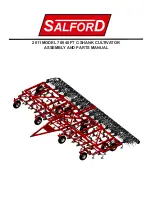
GB-4
- Tilling Pattern B – Make two passes over the area to
be tilled, the second overlapping the first.’
• To prevent tripping take particular care when moving
backwards and when pulling the tiller.
• Always let the tines rotate at top speed; do not work
in such a manner as to overload the tool.
• Never pass the tiller over the extension cord; make
sure the cord is always in a safe position behind your
back.
• When working on inclines, always stand diagonally to
the incline in a sturdy, safe position. Do not work on
extremely steep slopes.
Transport
Attention! Before transporting the tool, switch
off the motor.
The tines and the tool as such may be damaged if you
move the tool with the motor switched off, e.g., over
solid ground. Make sure that the tines do not touch the
ground. Use the wheel to move the tool. To do so, mount
the spur as shown in Fig. 2c.
Maintenance and storage
Before carrying out any maintenance opera
-
tions, cut off the electric power supply by dis
-
connecting the plug from the extension cable.
Clearing tines of foreign objects
During operation, a stone or root may become lodged
in the tines, or tall grass or weeds may wrap around the
tine shaft.
To clear the tines, release the trigger lever. Unplug the
tiller, and dislodge or remove any obstacles from the
tines or tine shaft.
To ease the removal of tall grass or weeds that are
wrapped around the tine shaft, you may remove one
or more of the tines from the tine shaft. See the Tines
Removal and Installation section in the manual.
Prior to each time the tool is used
• Check the connecting cable for signs of damage
or ageing (wear and tear). Replace the cable if it is
cracked, split or otherwise damaged.
• Check the condition of the cutting cylinder, and ensure
that all threaded connections are securely tightened.
• If the tines are blunt, take it to a specialist workshop
for repair, if necessary.
Once per season
• Lubricate the tines and shaft.
• At the end of the season, have the tool checked and
serviced in a specialist workshop.
Cleaning
Attention! Clean the tool after each use. Failure
to carry out proper cleaning may result in dam
-
age to the tool or cause it to malfunction.
Warning! Injury may occur when working on
the tines. Wear protective gloves !
Whenever possible, clean the tool right after you have
finished working with it.
• Clean the underside of the housing around the tines
and the protective shield and fender with a scrubbing
brush, and a brush or soft cloth dampened with a
mild soap and water mixture.
Never splash the tool
with water!
• To remove soil and debris from the tines and trans-
mission, use a stiff brush or dampened cloth.
• Clean the
air vents
; remove any remaining grass
or dirt.
• Once cleaned, wipe the tine and shaft dry and apply
a light coat of oil.
Tines Removal and Installation
(Fig.6)
Worn tines lead to poor performance and may overload
the motor.
Check the tines’ condition before each use. Sharpen
or replace tines when necessary. It is recommended to
have this done by a specialist.
Attention! Disconnect the mains supply and
wear protective gloves.
Removing all sets of teeth from the shaft
(Fig. 6)
• Remove the spring cotter pin and the locking pin, and
pull the set of teeth from the shaft.
• The sets of teeth are re-installed in reverse order.
Attention: The set of teeth (X) with the single-
sided shaft must always be installed on the
outside!
To remove and install tines from/to the tine bracket
If one or two pieces of a tine are broken, it is neces-
sary to change the damaged tine; it is not necessary to
replace the complete tine set.
• Loosen the screws on one side while holding the lock
nuts from the other side.
• Take off the damaged tine and replace it by a new
one.
Maintenance of the transmission
(Fig. 7)
• The transmission lubricant (grease) should be checked
and/or filled up about every 15 hours of operation or at
least once a year.
• The inlet screw plug (X) for the transmission lubricant
is located on the left side of the transmission housing.
• Note: As the transmission heats up during operation,
the grease used to lubricate the transmission assem-
bly may liquefy to oil.
• Put the tiller down on its right side and clean the
transmission housing before removing the drain screw
to prevent dirt and debris from getting into the trans-
mission.
• Use an Allan key (hexagon socket screw key) to
loosen the screw.
• Fill in as much grease (directly from the tube or using
a grease gun) until it comes out of the outlet bore.
• Use commercially available transmission lubricant
(gear grease) of the type Mobil EPO or similar.
Summary of Contents for FEM 1200
Page 2: ...1 8 10 9 6 7 4 5 1 3 2 2 1...
Page 4: ...3 6 4 2 4 7 7...
Page 5: ...4...
Page 6: ...5 X X A C B...
Page 40: ...RU 2...
Page 42: ...X 7 2c 7 3 3 3 4 I II I II 6 A B 2 RU 4...
Page 43: ...6 6 X 7 15 1 Mobil EPO RU 5...
Page 44: ...Ka 1 2 3 15 RU 6 36 12...
Page 52: ...b BG 2...
Page 54: ...II 5 2c 6 BG 4...
Page 55: ...6 D 7 15 n E Mobil EPO 36 12 BG 5...
Page 56: ...BG 6 1 2 3 15...
















































